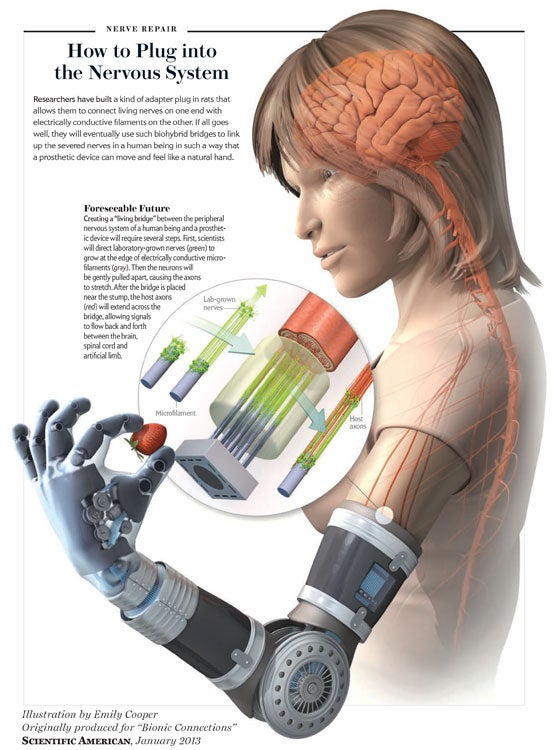This article was published in Scientific American’s former blog network and reflects the views of the author, not necessarily those of Scientific American
Advanced prosthetics have for the past few years begun tapping into brain signals to provide amputees with impressive new levels of control. Patients think, and a limb moves. But getting a robotic arm or hand to sense what it’s touching, and send that feeling back to the brain, has been a harder task.
The U.S. Defense Department’s research division last week claimed a breakthrough in this area, issuing a press release touting a 28-year-old paralyzed person’s ability to “feel” physical sensations through a prosthetic hand. Researchers have directly connected the artificial appendage to his brain, giving him the ability to even identify which mechanical finger is being gently touched, according to the Defense Advanced Research Projects Agency (DARPA). In 2013, other scientists at Case Western Reserve University also gave touch to amputees, giving patients precise-enough feeling of pressure in their fingertips to allow them to twist the stems off cherries.
The government isn’t providing much detail at this time about its achievement other than to say that researchers ran wires from arrays connected to the volunteer’s sensory and motor cortices—which identify tactile sensations and control body movements, respectively—to a mechanical hand developed by the Applied Physics Laboratory (APL) at Johns Hopkins University. The APL hand’s torque sensors can convert pressure applied to any of its fingers into electrical signals routed back to the volunteer’s brain.
On supporting science journalism
If you're enjoying this article, consider supporting our award-winning journalism by subscribing. By purchasing a subscription you are helping to ensure the future of impactful stories about the discoveries and ideas shaping our world today.
The extent of this feat will depend upon the details that DARPA still hasn’t disclosed. Nerves and the electrical wires needed to regulate the electronics in a prosthesis use very different kinds of signals. The latter depend on the flow of electronics across conductive materials, semiconductors and other components. The nervous system, meanwhile, is based on the release of signaling chemicals in the gaps between nerve cells. Nor would the human body take kindly to the wires and other devices needed to enable two-way communications between a prosthetic hand and the brain. In fact, the body’s efforts to rid itself of these implants would likely scar tissue around any interface and disrupt its functioning. A team of University of Pennsylvania neurosurgeons laid out these challenges in the January 2013 Scientific American article, “Bionic Connections.”
What’s needed is an adapter plug—a “living bridge”—that can translate signals between nerves and artificial limbs, according to the Penn neurosurgeons/researchers D. Kacy Cullen and Douglas Smith. The following graphic illustrates how such an adapter might work.

A key difference between the Cullen and Smith’s research and that of DARPA is that the Penn scientists are experimenting with ways to connect the nerve endings left behind on an amputee’s limb with the prosthetic connected to that stump. This approach—being investigated by a number of different researchers—would enable the brain to interpret the incoming signals as coming from a forearm, a hand and fingers. As mentioned above, the DARPA-funded research tied directly into the brain, a much more delicate and dangerous approach.
Even if such an adapter tied to peripheral nerves were to function as designed, Cullen and Smith are aware of the remaining hurdles. For starters, there’s no telling how long such an adapter would function before needing to be replaced, how the immune system might respond to the implants, or the brain’s ability to interpret signals sent from the prosthetic.